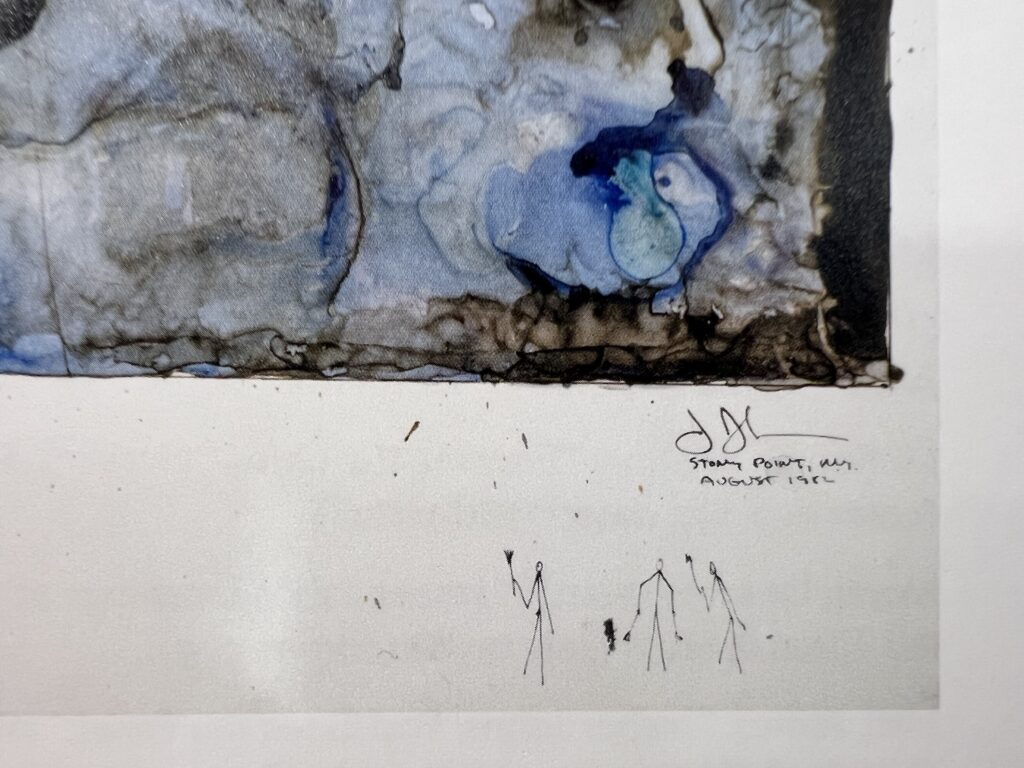
“I thought to add these little figures, which appear in a different drawing of mine, an old drawing. They’re in the bottom of Perilous Night, for John Cage.”
Oh hey, look, it’s Jasper Johns in 1989 discussing the addition of his little stick figures to another work for what sounds like the first time since he used them in 1982.

Johns is talking to filmmaker Judith Weschler, who produced Jasper Johns: Take An Object with photographer Hans Namuth in 1990. The short film is bracketed by two extended scenes of Johns at work: in 1972, painting in his own studio, and in 1989, printmaking at ULAE.
I’ve grown wary and weary of the pop fixation on Johns’s early note to himself— “Take an object/ Do something to it/ Do something else to it [Repeat].” But whaddyaknow, it works. Johns readily explains that the massive ULAE intaglio, The Seasons (1990) emerged from wanting to do something with the plates from editions of The Seasons besides canceling them. So he cut them up and pieced them together.

Weschler’s film gives a glimpse at one morning’s worth of intricacies involved. But as the last plate gets gently tapped into place, and the whole assemblage is ready for proofing, it struck me that adding the little figures is almost literally the last “Do something else to it” of the process.
For a short film, Johns sure has a lot of substantive comments. And watching him work is intense, specific, and contemplative. Whoever called him a hermit never watched him make prints; it seems logistically impossible to be both a hermit and a printmaker. And he talks in a specific but still open way about his process and his inspirations. Again, whoever called him tight-lipped or reticent, maybe he’s just not that into you?

But on the specific decision to add the little figures, it’s notable that it seems to come last, when everything else is done, or decided. In a way it seems obvious when they first appeared—in the margin, under the title and inscription—that the stick figures came last.
Their first reappearance as a purpose-built plate in a mosaiced intaglio print is the opposite of a quick doodle. But it underscores Johns’ take on their symbolic role in the process of making as well as looking. We read them as the first viewers, but remember, Johns put them there. So they could be a work in progress’s last judges.
Namuth & Weschler’s film begins in 1972, with Johns repainting the massive Dymaxion Map he’d sent to Expo 67 in Montreal. Because he’d had to paint its triangular sections separately, the first time he’d seen it all together was in the US Pavilion. And he didn’t like it, and brought it back into the studio to rework it.

Cut to 17 years later, and Johns is making a print by cutting up and piecing together fragments of The Seasons, a painting and print project which occupied years of his life in the 1980s, and which marked a major, autobiographical turning point in his work. However challenging the meticulous but technically sure processes of chopped intaglio, it must have been a welcome relief after the extraordinary psychological, philosophical, art historical, and compositional subjectivities involved in creating The Seasons.

The last moment in the film shows Johns and three ULAE printers studying the proof they’d realized that morning, and Johns declaring it a success, and then calling a break for lunch. It ends with Johns alone, looking and judging his work. It’s still unclear where the little guys came from before Perilous Night. But when they came back for The Seasons, Johns had a job for them, and put them right to work.

And when they were done, they went back into [a new] Perilous Night (1990) until Johns needed them for another job.

And all this comes together because I added a Hans Namuth photo of Rauschenberg & Twombly to the post about Captiva, and wondered if Namuth had a thing for artists’ feet.
Jasper Johns: Take An Object (1990) [judithweschler.com]
Previously, related : Jasper Johns’ Little Guys
Jasper Johns’ Little Guys: Origins
Little Guys Show Trials
